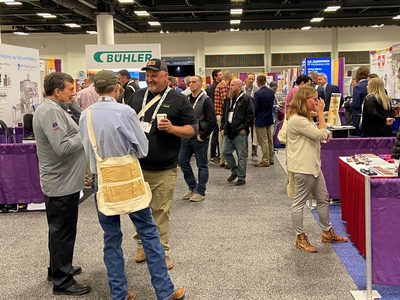Millers are making five-year business plans and are considering energy savings, mill flexibility, maintenance and building costs. Energy efficiency is one of the most important issues in the milling industry today, according to World Grain magazine’s annual survey of the international milling industry’s equipment and service suppliers. Some millers are asking for energy consumption of less than 45 kWh per tonne of wheat to be milled.
Millers are replacing old machines with more efficient equipment and want to increase milling capacities. Companies are investing in new projects, but they are approaching them with more caution, one supplier said.
Other concerns include employee safety and food safety. Suppliers said they are launching new equipment to prioritize these concerns, including new machinery for mixing factories.
Demand has greatly increased in Europe and North America, said several suppliers. Others noted more activity in Africa, Central America, the Caribbean and South America. There is high demand from emerging markets and developing countries, survey respondents said.
Indonesian mill built with expansion in mind
With expansion in mind, PT Nutrindo Bogarasa, part of the MAYORA Group, constructed a greenfield flour mill in Cilegon-Banten, Indonesia. The turn-key project, which included the milling building, silos, packing unit buildings and management offices, took nine months to complete, with operations starting in November 2015.
In the next two to three years, the company plans to build an identical second mill on the 33,000-square-meter site. The current mill occupies 1,740 square meters and is 20 meters tall. Production capacity is 500 tonnes per day with a flour extraction rate of 78% to 80%.
The facility also includes 15 3,000-tonne silos for total wheat storage capacity of 45,000 tonnes.
Alapala, based in Corum, Turkey, supplied the turn-key plant and machinery.
The roller mills are equipped with a belt system, which offers some advantages compared to a gear-typed roller mill, Alapala said. There is no need to modify gears, there is no oil consumption and periodic maintenance is minimized. Erection and dismantling time of the rolls is shorter, and the cost of operation and maintenance is low.
The control system is fully automatic by PLC with an operating system developed and supplied by Alapala.
PT Nutrindo Bogarasa uses soft U.S. wheat, and produces flour for biscuits and baguettes. A special bread flour also may be produced for local use. Cracker flour produced at the
facility is used by the MAYORA Group in its factory.
Brazilian flour producer adds mill
M. Dias Branco, a leading Brazilian biscuit and pasta maker and one of the largest wheat flour producers in the country, recently completed a new mill, Grande Moinho Eusébio in Ceará, Brazil. The project, completed in the second quarter of 2015, took a year to complete.
The mill has a capacity of 650 tonnes per day with total extraction of 78%, and wheat storage capacity of 37,000 tonnes. The facility may be expanded to include one more 650-tonne milling line.
This project is one of several that Sangati Berga, based in Fortaleza, Brazil, is working on in partnership with M. Dias Branco. Grande Moinho Eusébio produces two types of flour. Most of the flour production is used by M. Dias Branco for its pasta and biscuit lines. A second fraction is used for bakery and domestic use, with the main markets being supermarkets and distributors.
The mill’s cleaning section is fed by a precise dosage system made by the Sangati Berga differential gravimetric system ACCUFEED. This equipment works under the principle of weight decrease. The measured weight is continuously controlled and corrected, in order to obtain a maximum mix precision for the operation, from a technological and economic point of view.
The first wheat cleaning section includes: magnetics; a vibrating separator, model Vibroblock VB complete with air separator; destoners model SGS-T; an optical sorter complete with NIR; intensive scourers with air separator; and an ACQUA RATE automatic dampening system, complete with a new intensive dampener model ACQUAMIX-AMX. The new model provides homogeneous absorption of water by the grain, decreasing the resting time of the wheat and the energy consumption.
During the first cleaning stage, the light fraction of the wheat undergoes a special treatment, ensuring very clean wheat for the first break. At the same time, the healthy grain that would be used in the milling process is not discarded. This strong separation is possible by the destoner model SGS-T, Sangati Berga said.
After tempering, the grain undergoes a second cleaning that includes an intensive scourer, with open air separator, resulting in very clean wheat, to meet with the high quality standards of M. Dias Branco flour. Before going to roller mills, the wheat goes to an electronic scale, model POND 013 and magnetics. All circuits are aspirated by new high-efficiency filters FMS, with open-top compartments for easy maintenance. These filters have an automatic dispositive, which varies the frequency of the cleaning of the sleeves based on the filter load loss, providing energy economy in the mill’s pneumatic transport and compressed air system. This dispositive also increases efficiency in the cleaning process, reducing the need for sleeve changes.
The complete milling section includes PRIME roller mills and the FORTRESS plansifters with a new concept of sieves and drawers made of reinforced resin, and built in a single structure. This eliminates the need for any connecting elements, such as nails, screws and bonding materials, improving safety and hygiene parameters for the product. The mill also includes CLASS purifiers, vibrating turbo-sifters, centrifugal detachers, and more.
Sangati Berga also provided the whole system to transport the flour/bran to the silos, via pneumatic lines. The flour passes through safety plansifters, magnetics, electronic scales and a flour infestation destroyer before reaching the silos. In addition, a complete two-mixing section line was supplied.
Pan America Grain adds mill to storage silo
Pan America Grain started operations this June at its flour mill in San Juan, Puerto Rico. Omas, based in Padova, Italy, worked with Pan America to install the mill in an existing storage silo elevator tower, which was rearranged to meet the food processing hygiene standard.
The mill has the capacity to produce 150 tonnes per day, and is currently operating at 120 tonnes per day. It has been designed so that it could easily be expanded to 300 tonnes per day. The project, which cost $5 million, took 12 months to complete.
Omas said the mill is installed on the pre-cleaning elevator tower, which has 10 floors and is 45 meters tall. Total storage capacity is 200,000 tonnes.
Omas supplied the wheat mixing dozers; the full cleaning line, including Giotto wheat sterilizer to decrease wheat bacteria and conditioning time; photo separator; Galileo sifter; Michelangelo purifier; and Evolution roller mills. The cleaning line is already designed to reach a capacity of 15 tph.
The mill is equipped with IE3 premium efficiency motors and inverters on the largest aspiration fans for the lowest power consumption possible. The mill is WiFi enabled and will be operated by only one miller.
Pan America is able to mill soft and hard wheat to produce a wide range of flour.
The flour blending system is under the flour silo so that product may be delivered just in time. The mill may add ingredients to the flour.
Company adds durum wheat mill in Costa Rica
Molinos de Costa Rica, S.A., one of the largest flour and semolina mills in Central America and a market leader in the production of wheat flour and durum semolina, recently built a new facility for durum wheat milling in Alajuela, Costa Rica. The greenfield project took about a year to complete, and started operations in December 2015.
The facility is four stories tall and can mill 300 tonnes per day of durum wheat for the production of semolina for pasta. Ocrim, based in Cremona, Italy, supplied multiple pieces of equipment, including RMX stainless steel roller mills; SDX stainless steel purifiers; SFM/I modular plansifter; and a cleaning section.
The durum wheat, mostly from Canada, goes from a high-capacity steel bin directly to the cleaning house that includes an optical sorter and DHB debranners. After the milling process, the semolina goes straight to the pasta factory nearby with a pneumatic line, while the byproducts are stored in existing bins.
The mill is highly automated with the Ocrim-developed software. The energy efficiency is guaranteed with high efficiency motors and inverters, Ocrim said. Due to the large use of stainless steel during the process, high sanitary standards are easily reached.
Molinos de Costa Rica’s primary customer is one of the largest pasta producers in the country.
Uzuri adds second milling line to Kenya facility
Uzuri Foods Ltd. is nearing completion of its second milling line at its facility in Kenya, with work expected to be complete in the third quarter of 2016. Both lines will have a capacity of 450 tonnes per day. The flour extraction rate is 78% to 80%.
Each line includes 14 single-deck Millennium cast iron stainless PLC roller mills supplied by IMAS MILLERAL, based in Konya, Turkey; four double-deck Millennium cast iron stainless PLC roller mills; and four quadro plansifters.
All rolls are 1,250 mm. The intake and cleaning sections have a capacity of 20 to 22 tonnes per hour, and flour packing is done by a carousel machine.
IMAS MILLERAL said the mill is highly automated and energy efficient with automatic dampeners, scales, soft starters for pneumatic motors, automatic stops for silo conveyors and full automation. IMAS MILLERAL also applied its SmartLub automated lubrication system.
Total grain storage capacity at the facility is 18,000 tonnes. Wheat is sourced from countries worldwide, including Australia, Europe, Russia, Ukraine, North America and South America with qualities varying from low to very high proteins.
CLDS building a corn mill in the Philippines
CLDS Enterprises is in the process of building a greenfield corn mill in Lipa City, Philippines. The project is expected to be completed in December 2016.
Satake, based in Hiroshima, Japan, is supplying milling equipment for the project, including a milling separator with aspirator; destoner; maize degermer; leg aspirator; and rotary sifter. The facility will have a corn processing capacity of 5 tonnes per hour, and will produce cracked corn. There is room available to expand capacity.
CLDS will utilize its existing grain storage from its original feed business. Corn will be sourced domestically, and the final product will be used as feed for fighting gamecocks.
To view the slideshow, click here.






